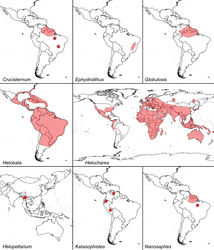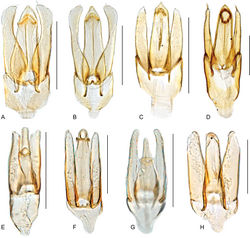Katasophistes
| Notice: | This page is derived from the original publication listed below, whose author(s) should always be credited. Further contributors may edit and improve the content of this page and, consequently, need to be credited as well (see page history). Any assessment of factual correctness requires a careful review of the original article as well as of subsequent contributions.
If you are uncertain whether your planned contribution is correct or not, we suggest that you use the associated discussion page instead of editing the page directly. This page should be cited as follows (rationale):
Citation formats to copy and paste
BibTeX: @article{Girón2021ZooKeys1045, RIS/ Endnote: TY - JOUR Wikipedia/ Citizendium: <ref name="Girón2021ZooKeys1045">{{Citation See also the citation download page at the journal. |
Ordo: Coleoptera
Familia: Hydrophilidae
Name
Katasophistes Girón & Short, 2018 – Wikispecies link – Pensoft Profile
- Katasophistes Girón & Short, 2018: 132.
Gender
Masculine.
Type species
Katasophistes merida Girón & Short, 2018: 136; by original designation.
Diagnosis
Medium to small beetles, body length 2.7–4.5 mm. Body shape oval to elongated in dorsal view; moderately and evenly convex in lateral view (Fig. 39). Color orange brown to dark brown, rather uniform along body regions (Fig. 39). Shape of head trapezoid. Eyes relatively small, subquadrate, at most only slightly emarginated anteriorly, moderately projected from outline of head. Clypeus trapezoid, with anterior margin broadly emarginate. Labrum fully exposed. Mentum with strong median anterior depression sometimes limited by low transverse carina; surface of mentum with lateral oblique ridges (Fig. 39C, F). Antennae with nine antennomeres; cupule slightly asymmetric, with rounded outline. Maxillary palps moderately long, 0.7 × to nearly as long as width of head; inner margin of maxillary palpomere 2 slightly curved near apex, outer margin curved, sometimes strongly, along apical half (Fig. 39C, F). Each elytron with five rows of deep/large systematic punctures; elytra without sutural striae, with outer margins slightly flared; serial punctures absent (Fig. 39A, D). Prosternum slightly convex to tectiform. Posterior elevation of mesoventrite, with a well-defined, curved transverse ridge; anapleural sutures forming an obtuse angle, separated at anterior margin by distance 0.2–0.3 × the width of anterior margin of mesepisternum. Metaventrite densely pubescent, except for large median rhomboid glabrous patch (Fig. 39C, F). Protibiae with spines of anterior row hair-like, semi erect, relatively long and thick. All tarsomeres bearing long apical hair-like setae on dorsal face, and hair-like spines on ventral face of tarsomeres 2–4. Posterior femora glabrous at most along apical third (Fig. 39C, F). Fifth abdominal ventrite apically truncate to slightly emarginate, with fringe of stout setae. Aedeagus trilobed (Fig. 40A–D), nearly parallel sided, with basal piece between 0.5 and 1.1 × length of parameres; median lobe wider than each paramere, gradually narrowing apically, with conspicuous median longitudinal sclerotization, and well-developed lateral basal apodemes; apex of median lobe acute; parameres nearly as long as median lobe, with apical setae; gonopore preapically situated.
Differential diagnosis
At first glance Katasophistes may appear similar to some species of Chasmogenus, however the lack of sutural striae easily separates the two. The enlargement of the rows of elytral systematic punctures is also rare within the Acidocerinae (found in some Chasmogenus and Agraphydrus) and will separate it from New World Helochares, with which it may also be confused.
Distribution
Neotropical: Ecuador, Peru, Venezuela; Fig. 5.
Natural history
One species (K. merida) is known from seepages in the Venezuelan Andes. The other described species are known from forested stream pools with abundant detritus in Ecuador and Peru.
Larvae
Immature stages are not known for the genus.
Taxonomic history
Katasophistes was only recently described.
Remarks
There are four known species of Katasophistes, all of them from Andean or Andean-adjacent localities.
Species examined
Holotypes and paratypes of all known species were available for this study.
Selected references
Girón and Short 2018[1]: original description of the genus and all its known species; Short et al. 2021[2]: phylogenetic placement.
Taxon Treatment
- Girón, J; Short, A; 2021: The Acidocerinae (Coleoptera, Hydrophilidae): taxonomy, classification, and catalog of species ZooKeys, 1045: 1-236. doi
Images
|
Other References
- ↑ Girón J, Short A (2018) Three new genera of acidocerine water scavenger beetles from tropical South America (Coleoptera, Hydrophilidae, Acidocerinae).ZooKeys768: 113–158. https://doi.org/10.3897/zookeys.768.24423
- ↑ 2.0 2.1 Short A, Girón J, Toussaint E (2021) Evolution and biogeography of acidocerine water scavenger beetles (Coleoptera: Hydrophilidae) shaped by Gondwanan vicariance and Cenozoic isolation of South America.Systematic Entomology46(2): 380–395. https://doi.org/10.1111/syen.12467
![Figure 2. Phylogeny of the Acidocerinae simplified from Short et al. (2021)[2], indicating the distribution, preferred habitat, and currently described number of species for each genus. For habitat, filled black circles indicate that at least some species of the genus are commonly found in this habitat; light grey circles indicate the genus has been found in this habitat, but is rare or not typical for the group; white circles indicate no species have been recorded for the genus in this habitat.](https://species-id.net/o/thumb.php?f=Zookeys-1045-001-g002.jpg&width=184)


